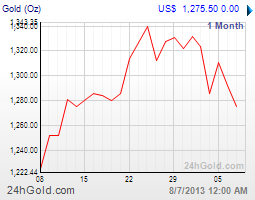Commentary for Wednesday, Aug 7, 2013– Gold closed up $2.90 today to finish the day at $1286.10 after seeing overnight lows of $1273.00 (Hong Kong/London) and domestic lows in New York of $1271.00. The Bank of England again joined the quantitative easing chorus today saying they will keep interest rates low for an extended period of time. In the midst of this thin trading and summer holiday there are some contrarian traders who believe gold will once again soon test the $1350.00 level because this market has continued to see the kitchen sink and remains relatively stable.

Silver has unhooked from gold almost unchanged today down $0.02 at $19.49 and the physical trade remains quiet but steady if that makes any sense. And keep in mind that imports of silver to India the first five months of this year exceeded all of last year so someone is stocking up.
Platinum was higher by $11.00 at $1438.00 and palladium was unchanged at $723.00.
The trend for the dollar this past week has been basically lower and today it continued this short term trend so I would have expected higher prices for gold. What we got was a whimper not a shout so the price of gold is reacting more to taper talk than following its inverse relationship to the dollar. Everyone seems over worried about what the Fed will do on the short term, even some of the fizz is coming off the stock market in reaction to taking away the currency punch bowl.
This from Chris Gaffney (EverBank World Markets) supports the contention that the Federal Reserve will not end quantitative easing as some believe. “The Bank of Japan redoubled its stimulus efforts back in April, promising to double its bond holdings and boost purchases of assets in an all out effort to get inflation up to 2 percent over the next two years. And during their July meeting, while other major central banks were discussing a possible ‘tapering’ of their stimulus programs, BOJ officials indicated they would continue their aggressive purchases of long term debt at the current annual pace of 60 – 70 trillion yen per year. Inflation finally crept back into the Japanese economy last month, with June CPI being reported at .2%. This was the first positive YOY change in prices in over a year. Some currency traders believe that this positive CPI number will encourage BOJ policy makers to leave the current levels of stimulus unchanged. While I don’t think the BOJ will make a bid announcement like it did in April, I also don’t think they are ready to start any talk of tapering their stimulus programs, so this rally in the Japanese yen will probably be short lived. The other big mover in the currency markets overnight was the Pound sterling which has risen over 2% vs. the US$ during the first week of August. New central bank Governor held a press conference yesterday to give the markets some guidance on future BOE policy. The Bank of England raised their GDP growth projections for both 2013 and 2014, expecting 1.5% and 2.7% growth in each respective year. Carney suggested the 7 percent level for unemployment is a threshold and not a ‘trigger’ which would automatically begin a reduction of the stimulus programs. Instead, officials of the Monetary Policy Committee will begin to reassess the QE program once employment improves to that point. A report released yesterday showed UK industrial production beat forecasts in June, climbing 1.1% after stagnating for the past three months. Another report showed factory output in the UK jumped 1.9% last month, also beating economists projections. But in spite of the positive economic data which has been filtering out of the UK, BOE officials said they still stand ready to expand their quantitative easing program if needed. Sounds like QE is here to stay for a while in both England and Japan; and I believe the US will probably keep their bond buying at current levels through the end of 2013 also. The industrialized world has become addicted to stimulus, and all of these major central banks want to wait until they are absolutely sure their economies are strong enough to withstand the ‘withdrawal symptoms’ which they know will accompany the eventual tapering of stimulus.”
I appreciate everyone should be tired of hiring about the possibility of tapering by the Fed but for the time being this is the real metric driving the price of gold. The walk in business and phone trade today showed no excitement at all so while prices seem cheap enough for longer term players they certainly don’t seem to be in much of a hurry. Like us on Facebook and follow us on Twitter @CNI_golddealer. Thanks for reading and enjoy your evening. These markets are volatile and involve risk: Please Read Before Investing
Written by California Numismatic Investments (www.golddealer.com).




